

The Bookshelf is for readers who like having a choice between online and hardcopy documents. For each document in our BEA TUXEDO information set, we have provided HTML and PDF versions. If you prefer reading hardcopy documents, you can open and print the PDF files by using Adobe Acrobat Reader.
![]()
Don't have Adobe Acrobat Reader? It's free! Get it from the Adobe Web site.
Click here for PDF tips.
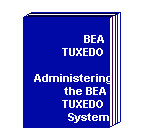 For information about administering BEA TUXEDO applications, see the BEA WebLogic
Enterprise Administration Guide.
[HTML Version]
[PDF Version]
For information about administering BEA TUXEDO applications, see the BEA WebLogic
Enterprise Administration Guide.
[HTML Version]
[PDF Version] |
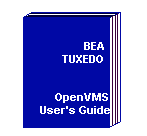 This document describes the BEA
TUXEDO for OpenVMS product and provides instructions for building BEA TUXEDO applications
on an OpenVMS platform. [HTML Version]
[PDF Version] This document describes the BEA
TUXEDO for OpenVMS product and provides instructions for building BEA TUXEDO applications
on an OpenVMS platform. [HTML Version]
[PDF Version] |
|
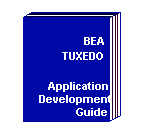 This document acquaints new users with the BEA TUXEDO system,
introduces new terms, and describes the application development process using a sample
application. [HTML Version]
[PDF Version] This document acquaints new users with the BEA TUXEDO system,
introduces new terms, and describes the application development process using a sample
application. [HTML Version]
[PDF Version] |
 This document provides a high-level view of each
component of the BEA TUXEDO system: the core system, Workstation, /Q, Domains, and TxRPC.
[HTML Version] [PDF Version] This document provides a high-level view of each
component of the BEA TUXEDO system: the core system, Workstation, /Q, Domains, and TxRPC.
[HTML Version] [PDF Version] |
|
 This
document describes how to install and use the BEA TUXEDO system on the AS/400 platform.
[PDF Version] This
document describes how to install and use the BEA TUXEDO system on the AS/400 platform.
[PDF Version] |
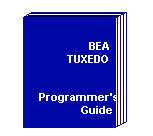 This document provides information on coding
application clients and servers. It reviews: the Application Transaction Monitor Interface
(ATMI), how to receive messages from client processes, send messages between servers, and
return responses to clients. [HTML Version]
[PDF Version] This document provides information on coding
application clients and servers. It reviews: the Application Transaction Monitor Interface
(ATMI), how to receive messages from client processes, send messages between servers, and
return responses to clients. [HTML Version]
[PDF Version] |
|
 This document provides information
for COBOL programmers who develop application clients and servers using the COBOL language
binding ATMI. It also describes the BEA TUXEDO application development process. [HTML Version] [PDF Version] This document provides information
for COBOL programmers who develop application clients and servers using the COBOL language
binding ATMI. It also describes the BEA TUXEDO application development process. [HTML Version] [PDF Version] |
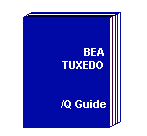 This document describes how to store a request
in a BEA TUXEDO application for guaranteed processing at a later time. [HTML Version] [PDF Version] This document describes how to store a request
in a BEA TUXEDO application for guaranteed processing at a later time. [HTML Version] [PDF Version] |
|
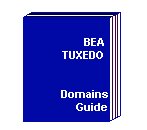 This document describes how to configure and administer applications
that take advantage of Domains, a BEA TUXEDO system feature that enables multiple
applications to communicate. [HTML Version]
[PDF Version] This document describes how to configure and administer applications
that take advantage of Domains, a BEA TUXEDO system feature that enables multiple
applications to communicate. [HTML Version]
[PDF Version] |
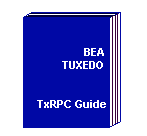 This document provides information for programmers using the remote procedure
call feature (TxPRC) of the BEA TUXEDO system. [HTML Version] [PDF Version] This document provides information for programmers using the remote procedure
call feature (TxPRC) of the BEA TUXEDO system. [HTML Version] [PDF Version]
|
|
 This document describes the function, benefits, and costs of using
the File Manipulation Language (FML). It also explains how to use FML or C language
functions to define and manipulate storage structures called fielded buffers in
applications. [HTML Version] [PDF Version] This document describes the function, benefits, and costs of using
the File Manipulation Language (FML). It also explains how to use FML or C language
functions to define and manipulate storage structures called fielded buffers in
applications. [HTML Version] [PDF Version] |
 This document provides information on installing
and upgrading the BEA TUXEDO system on Windows 95 and NT. It also provides instructions on
developing and configuring an application on Windows NT. [HTML Version] [PDF Version] This document provides information on installing
and upgrading the BEA TUXEDO system on Windows 95 and NT. It also provides instructions on
developing and configuring an application on Windows NT. [HTML Version] [PDF Version] |
|
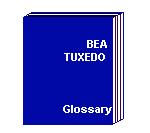 This document defines terms used in the BEA TUXEDO documentation.
[HTML Version] [PDF Version] This document defines terms used in the BEA TUXEDO documentation.
[HTML Version] [PDF Version] |
 This document describes how to access a BEA
TUXEDO application from a network of workstations. [HTML Version] [PDF Version] This document describes how to access a BEA
TUXEDO application from a network of workstations. [HTML Version] [PDF Version]
|
|
 This document explains how to install the BEA TUXEDO system software
and online documentation. It assumes a knowledge of the UNIX operating system and
workstation platforms on which the BEA TUXEDO system runs. [HTML Version] [PDF Version] This document explains how to install the BEA TUXEDO system software
and online documentation. It assumes a knowledge of the UNIX operating system and
workstation platforms on which the BEA TUXEDO system runs. [HTML Version] [PDF Version] |
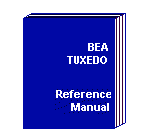 . . |
|
 The BEA WebLogic Enterprise and BEA TUXEDO System Messages are numbered and organized in catalogs, based on
the parts of the BEA WebLogic Enterprise or BEA TUXEDO system from which they are generated.
[HTML Version] [PDF Version]
The BEA WebLogic Enterprise and BEA TUXEDO System Messages are numbered and organized in catalogs, based on
the parts of the BEA WebLogic Enterprise or BEA TUXEDO system from which they are generated.
[HTML Version] [PDF Version] |
||
![]() You can also click hyperlinked
cross-references to other chapters and sections within a PDF file.
You can also click hyperlinked
cross-references to other chapters and sections within a PDF file.
Copyright © 1999 BEA Systems, Inc. All Rights Reserved.